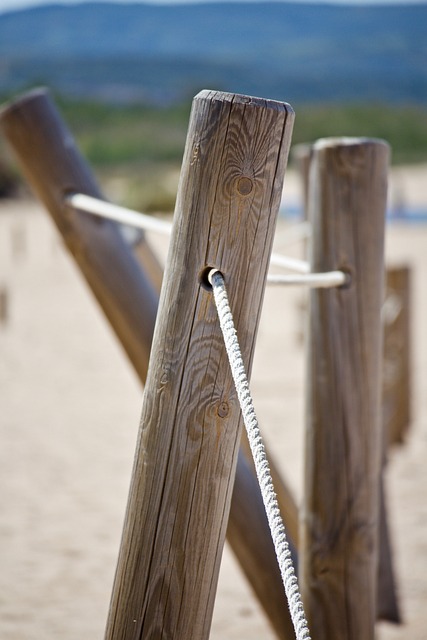In New Bedford, MA, the push for eco-friendly solutions is not just a trend but a strategic shift towards sustainability. This article delves into the world of green fencing materials and their multifaceted benefits for the city’s landscape. We explore environmentally conscious options available to homeowners and businesses, highlighting the advantages ranging from reduced carbon footprint to enhanced local ecosystems. By understanding these sustainable choices, New Bedford can continue its journey towards an eco-conscious future, one fence at a time.
- Exploring Eco-Friendly Fencing Options in New Bedford
- Benefits of Using Sustainable Fencing Materials
- Common Eco-Materials for Durable Fences
- Installation and Longevity: An Environmental Perspective
- Local Availability & Support for Green Initiatives
Exploring Eco-Friendly Fencing Options in New Bedford
New Bedford, MA, residents increasingly seek eco-friendly fencing options to enhance their outdoor spaces while contributing to a greener environment. This trend aligns with a broader global shift towards sustainability and responsible land management. Exploring these options offers several environmental and aesthetic benefits.
One prominent choice is using recycled plastic or composite fences. These materials are durable, require minimal maintenance, and significantly reduce the need for new plastic production—a major environmental concern. Alternatively, natural barriers like bamboo or wooden fences from sustainably managed forests provide a rustic appeal while supporting local ecosystems. Each option contributes to a more sustainable New Bedford, offering both functional fencing and an environmentally conscious approach.
Benefits of Using Sustainable Fencing Materials
In New Bedford, MA, opting for eco-friendly fencing materials offers a multitude of benefits both for your property and the local environment. These sustainable alternatives reduce carbon footprint by minimizing the transportation distances associated with conventional fencing products, which often originate from distant manufacturing hubs. Using recycled or biodegradable materials also diminishes waste accumulation in landfills, fostering a circular economy where resources are reused and repurposed.
Moreover, eco-friendly fences contribute to enhancing biodiversity by providing habitats for local wildlife. Natural materials like bamboo or recycled plastic can support the growth of plants and insects, creating microecosystems that support a healthier, more balanced ecosystem. These sustainable options also ensure long-term cost savings as they are durable, low-maintenance, and resistant to rot, rust, or other environmental damage, eliminating the need for frequent repairs or replacements typical of conventional fencing.
Common Eco-Materials for Durable Fences
When it comes to eco-friendly fencing materials, New Bedford residents have a plethora of options that offer both durability and environmental benefits. One of the most common choices is recycled plastic, which is often used to create picket fences or post-and-rail styles. These materials are highly durable, resistant to rot and rust, and can last for decades with minimal maintenance. They also reduce the need for new plastic production, cutting down on landfill waste.
Another popular eco-choice is treated wood, typically made from cedar or pressure-treated pine. This option offers excellent resistance to moisture and insects, ensuring a long lifespan. Treated wood fences not only provide privacy but also create a natural, aesthetically pleasing look that complements any landscape. Additionally, these materials can be recycled at the end of their useful life, further minimizing environmental impact.
Installation and Longevity: An Environmental Perspective
The installation process for eco-friendly fencing materials often aligns with their longevity, both key considerations from an environmental standpoint. Unlike traditional fencing that may require extensive excavation and heavy machinery, many eco-friendly options are designed to be easily installed, minimizing site disruption. For instance, recycled plastic or composite fences can be quickly assembled using simple tools, reducing construction waste and energy consumption.
Moreover, these materials’ durability translates into reduced need for frequent replacement, lowering the environmental impact associated with manufacturing and disposal. In New Bedford, MA, where local ecosystems thrive on balance, long-lasting fencing contributes to a more sustainable landscape. By choosing eco-friendly options, residents can ensure their fences not only enhance property aesthetics but also stand the test of time, preserving natural beauty for future generations.
Local Availability & Support for Green Initiatives
New Bedford, MA, is lucky to have a thriving community dedicated to sustainable practices, and this commitment extends to eco-friendly fencing options. The local availability of such materials is a significant advantage for residents and businesses aiming to reduce their environmental footprint. Local hardware stores and garden centers often stock a range of natural barriers, from bamboo and wood chips to recycled plastic posts and chains. This accessibility makes it easier for New Bedford folks to embrace green initiatives without compromising on quality or style.
Moreover, supporting locally sourced eco-friendly products encourages the development of an environmentally conscious economy. The demand for these materials fosters partnerships between local businesses and sustainable manufacturers, contributing to a circular system where resources are retained within the community. This approach not only benefits the environment but also strengthens the local business scene, ensuring that New Bedford remains at the forefront of ecological stewardship.
